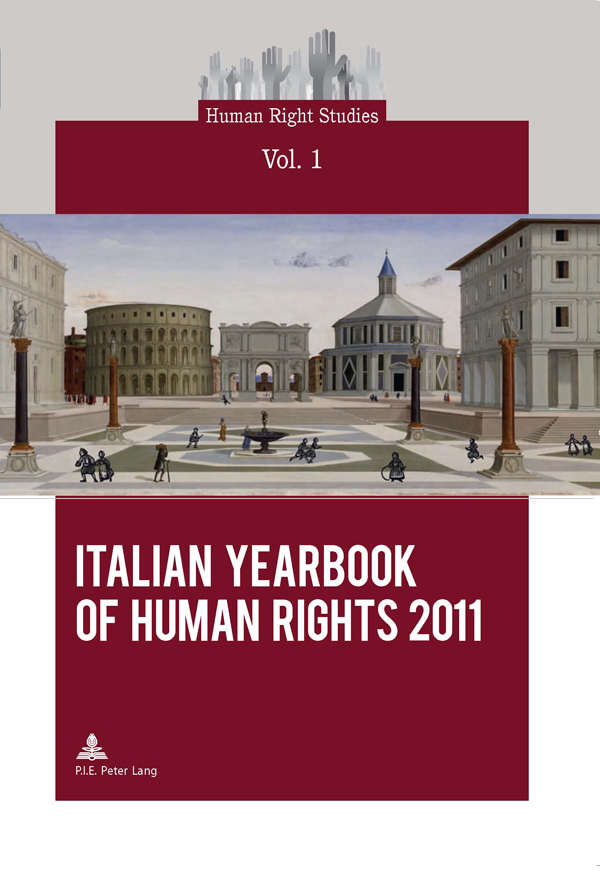Raccolte

Italian Yearbook of Human Rights 2011
- Tipologia pubblicazione
- Annuario italiano dei diritti umani
- Casa editrice
- Peter Lang International Academic Publishers
- Città
- Bruxelles
- Pagine
- 320
- ISBN
- 978-90-5201-858-4
- Lingua
- EN
The legal and political significance of human rights has increased enormously all over the world. The Italian Yearbook of Human Rights 2011 provides a dynamic picture of laws, institutions, policies and case law that have implemented international human rights norms in Italy over the past few years, particularly in 2010. The volume has four main sections, which concern respectively: Italy’s adaptation to international human rights law; the human rights infrastructure both at national and sub-national levels; Italy in dialogue with the international machinery; and national, European and international case law.
The Yearbook is the first volume in a series edited by the Centre for Human Rights and the Rights of Peoples of the University of Padua, in cooperation with the UNESCO Chair in Human Rights, Democracy and Peace at the same University. The Centre, founded in 1982 with the support of the Region of Veneto, carries out research and training programmes according to an interdisciplinary approach. It hosts the Jean Monnet Centre of Excellence on intercultural dialogue and human rights and edits the quarterly journal Pace diritti umani/Peace human rights. The Centre also works in cooperation with the European Commission, the Council of Europe, the United Nations High Commissioner for Human Rights and UNESCO, as well as with civic organizations, schools and local authorities.
Table of contents
PART I. IMPLEMENTATION OF INTERNATIONAL HUMAN RIGHTS LAW IN ITALY
International Human Rights Law
I. Legal Instruments of the United Nations
II. Legal Instruments on disarmament and Non-proliferation
III. Legal Instruments of the Council of Europe
IV. European Union Law
Italian Law
I. The Constitution of the Italian Republic
II. National Legislation
III. Municipal, Provincial and Regional Statutes
IV. Regional Laws
PART II. THE HUMAN RIGHTS INFRASTRUCTURE IN ITALY
National Human Rights-related Bodies
I. Parliamentary Bodies
II. Governmental Bodies
III. Independent Authorities
IV. Non-governmental Organisations
V. Human Rights Teaching and Research in Italian Universities
Human Rights Structures at a Sub-national Level
I. Peace Human Rights Offices in Municipalities, Provinces and Regions
II. The Ombudsman in Municipalities, Provinces and Regions
III. Ombudsman National Coordination
IV. Network of Children’s Commissioners
V. National Coordination of Local Authorities for Peace and Human Rights
Region of Veneto
I. Department for International Relations, International Cooperation, Human Rights and Equal Programmes
II. Committee for Human Rights and the Culture of Peace
III. Archive “Pace Diritti Umani – Peace Human Rights”
IV. Venice for Peace Research Foundation
V. Commissioner for Children and Adolescents
VI. Ombudsman
VII. Regional Commission for Equal Opportunities between Men and Women
VIII. Integrated Network of Regional Observatories on Social Policies
IX. Regional Observatory on Immigration
PART III. ITALY IN DIALOGUE WITH INTERNATIONAL HUMAN RIGHTS INSTITUTIONS
The United Nations System
I. General Assembly
II. Human Rights Council
III. High Commissioner for Human Rights (OHCHR)
IV. High Commissioner for Refugees (UNHCR)
V. Treaty Bodies
VI. Specialised United Nations Agencies
Council of Europe
I. Parliamentary Assembly
II. Committee of Ministers
III. European Court of Human Rights
IV. European Committee for the Prevention of Torture
V. European Committee of Social Rights
VI. Commissioner for Human Rights
VII. European Commission against Racism and Intolerance
VIII. Advisory Committee on the Framework Convention for the Protection of National Minorities
IX. Standing Committee of the European Convention on the Exercise of Children’s Rights
X. European Commission for Democracy through Law
European Union
I. European Parliament
II. European Commission
III. Council of the European Union
IV. Court of Justice of the European Union
V. European External Action Service
VI. Fundamental Rights Agency
VII. European Ombudsman
Organisation for Security and Cooperation in Europe
I. Office for Democratic Institutions and Human Rights (ODIHR)
II. High Commissioner on National Minorities
III. OSCE Representative on Freedom of the Media
IV. Special Representative and Co-ordinator for Combating Trafficking in Human Beings
International Humanitarian and Criminal Law
I. Adapting to International Humanitarian and Criminal Law
II. The Italian Contribution to Peace-keeping Missions and Other International Missions
PART IV. NATIONAL AND INTERNATIONAL CASE-LAW
Human Rights in Italian Case-law
I. The “Communitarisation” of International Human Rights Norms
II. Dignity of the Person
III. Discrimination
IV. Immigrants’ Rights
V. Children
VI. International Protection, Asylum
VII. Criminal Trial and Execution of the Penalty
VIII. Expropriations and the Right to Peaceful Enjoyment of Property
IX. Reasonable Length of Judicial Proceedings
X. Right to Vote
Case-law of the European Court of Human Rights Concerning Italy
I. Excessive Length of Trials and “Pinto on Pinto” Cases
II. Right to Property, “Indirect Expropriations” and Just Satisfaction
III. Criminal Procedures, Prison System, Reduction to Slavery
IV. Fair Civil Trial
V. Alien Deportations and the Risk of Torture or Inhuman Treatment
VI. Parliamentary Immunity, Electoral Law
VII. Adoption and Foster Care
VIII. Telephone and Environmental Interception
Table of Cases
Research and Editing Committee

